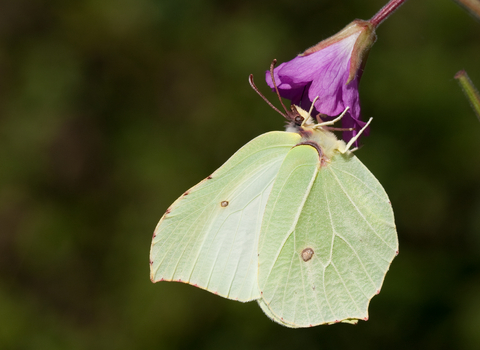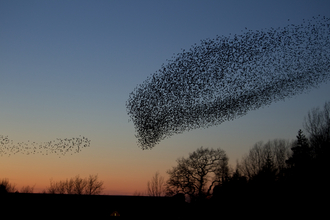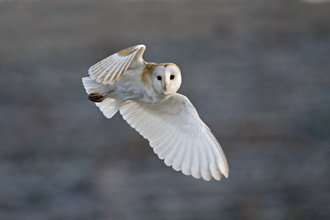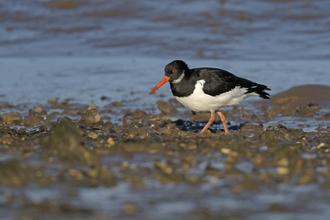Insects are a lot less obvious in winter. It’s a tough time to be active, with cold weather, storms and a shortage of food. Bees and butterflies mostly disappear, popping up again as spring approaches and the weather starts to improve. But where do they go?
Insects have their own version of hibernation, known as diapause. It’s basically like they push pause on their lifecycle, shutting down until conditions improve and they can become active again. They can do this at different stages – some might see out the winter as adults, pupae, larvae or even eggs.
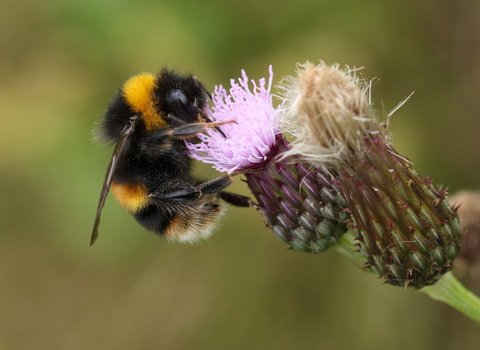
Buff-tailed bumblebee © Vaughn Matthews
Bees
There are more than 250 species of bee in the UK, so there are also different strategies for avoiding the woes of winter.
The hives of feral honeybees can survive from year to year. Many of the workers will die off, but the queen and some workers stay active over winter. They’ll build up honey reserves to keep them going and cluster together, shivering to generate heat and warm the hive.
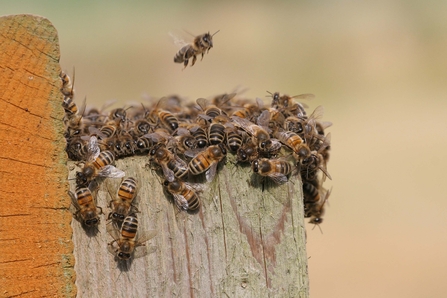
Honey Bee swarm ©Margaret Holland
Bumblebee colonies don’t last so long, usually just a few months. New queens are born in late summer. They mate, fatten up and then seek out somewhere sheltered to spend the winter. It could be an old rodent hole, a log pile or a compost heap. They’ll shut down and wait for spring, when they emerge, lay their eggs and start a colony of their own. All the other bees will die off as winter approaches.
Buff-tailed bumblebee queen flying to her nest © Nick Upton
However, some queens no longer wait for spring. Buff-tailed bumblebee colonies are now appearing in autumn and lasting through winter. They seem to be taking advantage of milder winters and non-native ornamental plants, which offer flowers to feed on when native plants aren’t available.
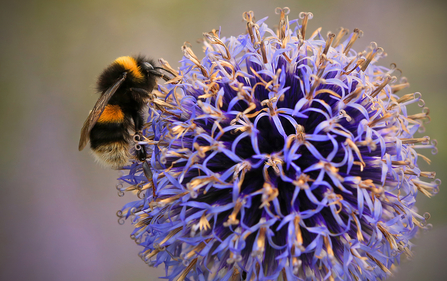
Buff-tailed Bumblebee ©Jon Hawkins - Surrey Hills Photograhpy
Most of the UK’s bees are solitary bees, which don’t live in communal colonies. They have short lives. A female lays her eggs in a nest, which could be in the ground, a plant stem or in some cases a snail shell! Each egg gets sealed into its own compartment, with a supply of food. The egg hatches and the larva feasts, eventually pupating and becoming an adult that will emerge the following spring.
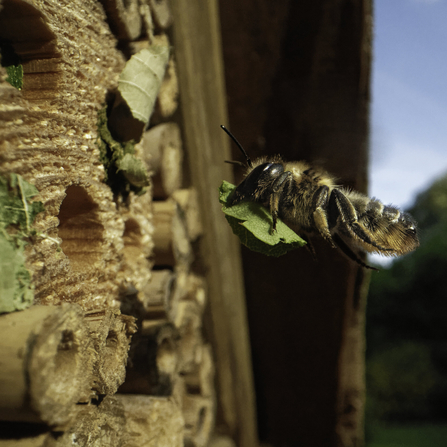
Wood-carving leafcutter bee flying towards an insect hotel with a leaf to seal her nest © Nick Upton
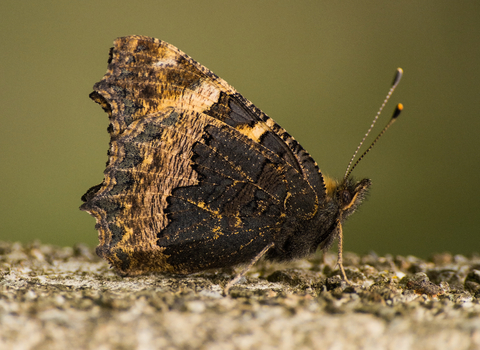
Small tortoiseshell © Bob Coyle
Butterflies
Like bees, different butterflies (and moths!) have different winter survival strategies. Most shut down for the season, entering diapause as either an egg, a caterpillar, a pupa or an adult. Remarkably, painted ladies avoid the winter altogether by migrating south in autumn!
Larvae
Most of the UK’s butterflies and moths spend the winter in their larval form, as caterpillars. Some will just huddle down in leaf litter or clumps of grass below their favourite food plant. Others might create their own shelter to give them a little more protection. Large skipper caterpillars use silk to spin grass blades together, forming a tube they can hide in. Marsh fritillary caterpillars spend the winter together in a communal web.
Some species have much more elaborate plans. Blue butterflies have complex relationships with ants and the large blue is no exception. When caterpillars first hatch in summer they feed on leaves, but as they grow their tastes change. They drop to the floor and produce a sugary liquid that attracts ants. Then they mimic an ant larva, tricking the ants into carrying the caterpillar down into their nest. Once inside, they feed on ant grubs until they’re fully grown. This is where they’ll spend the winter, deep inside an ant nest. They’ll pupate in spring and the adult will crawl back outside.
A web of marsh fritillary caterpillars © Vaughn Matthews
Pupae
The second most popular choice is to spend the winter as a pupa, wrapped in a protective chrysalis. The caterpillars will fatten up in spring or summer, find a place to pupate and then stay there over winter. In most cases, the transformation from caterpillar to butterfly is put on pause over winter. It will resume in spring, so the adult can emerge.
Pupae are often stuck to plant stems or hidden in leaf litter. One of the pupae you’re most likely to see is that of the large white. They can sometimes be found on the outer walls of houses, if you have a garden with plenty of food for the caterpillars. They’re wonderfully angular, alien-looking structures covered in spots and speckles.
The pupa of a large white © Vaughn Matthews
Eggs
Some butterflies spend the winter inside their egg, waiting for warmer weather to hatch. One example is the rare black hairstreak. The adults fly for a very short time around June, when females lay eggs on blackthorn twigs. The larva develops inside the egg and is fully formed by winter. But since the twigs are bare in winter, it doesn’t emerge. Instead, it enters diapause, emerging in spring when there are tasty buds and leaves to eat.
Brown hairstreaks also spend the winter as eggs on blackthorn trees, but their larvae only partially develop inside before entering diapause. They spend the winter dormant and their development resumes in spring.
Brown hairstreak egg © Vaughn Matthews
Adults
A small number of butterflies spend the winter in their flying form. They’ll find a sheltered spot to tuck themselves away and shut down for the season. Though, on sunny days, the warmer temperatures might cause them to stir and venture out.
Hiding spots can include caves, tree cavities, dense evergreens like ivy, or even sheds and garages. Their dark underwings help them blend in with their surroundings. Occasionally, butterflies find their way into houses and mistake them for the perfect place to spend the winter. As the weather cools, they enter their hibernation-like state. But the problem comes when our heating goes on, warming them up and causing them to become active.
Peacock, small tortoiseshell, comma, red admiral and brimstone butterflies all spend the winter as an adult.
Comma © Janet Packham

